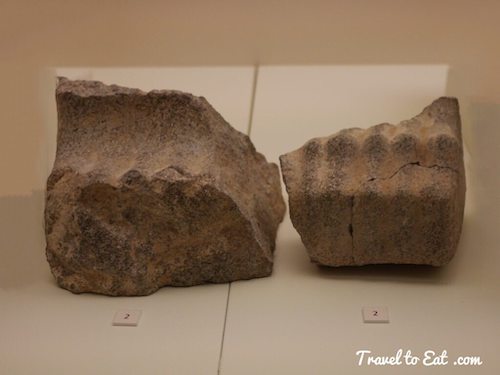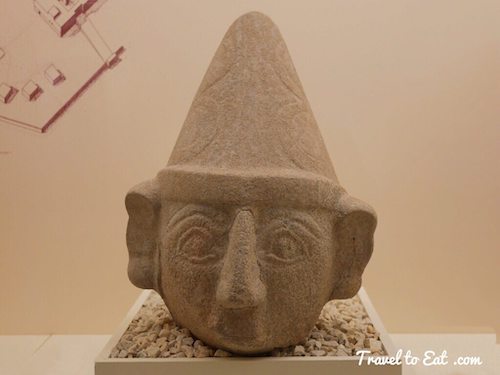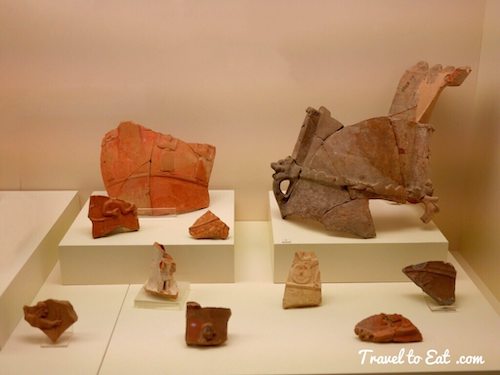
The Hittites, one of the great Bronze Age civilizations of the Mideast, are less well known than other great ancient civilizations such as the Greeks, Sumarians, Persians and Egyptians but no less deserving of our attention. For a long time, the Hittites were only known to historians as an obscure tribe mentioned in the Bible. In 1834, when archeologist Charles Texier stumbled upon the ruins of Hattusha (modern-day Boghazkoy/Bogazköy), his discovery went unrecognized. The Hittites were an Anatolian people who established an empire at Hattusa in north-central Anatolia around 1750 BC. This empire reached its height during the mid-14th century BC under Suppiluliuma I, when it encompassed an area that included most of Asia Minor as well as parts of the northern Levant and Upper Mesopotamia. After about 1180 BC, the empire came to an end during the Bronze Age collapse. The two main periods of Hittite history are customarily referred to as the Old Kingdom (1700-1500 BC) and the New Kingdom, or Empire (1400-1180 BC). The less well-documented interlude of about a hundred years is sometimes referred to as the Middle Kingdom. The early Hittites, whose prior whereabouts are thought to be in the southern Ukraine, borrowed heavily from the pre-existing Anatoloian Hattian and Hurrian cultures, and also from that of the Assyrian colonisers—in particular, the cuneiform writing and the use of cylindrical seals. The Boğazköy Museum is located 82 km southwest from Corum, in the district of Bogazkale. The museum, displaying excavation finds from the Hittite capital of Hattusha, opened on September 12 1966 and was completely refurnished in 2011.


In these two maps, we can summarize the arrival and departure of the Hittite Empire. The top map summarizes the “Kurgan” hypothesis, which is a theory that Indo-European languages originated in the southern Ukraine and spread east and west to form a common language history. The Anatolian migration (indicated with a dotted arrow) could have taken place either across the Caucasus or across the Balkans. The magenta area corresponds to the assumed Urheimat (Samara culture, Sredny Stog culture). The red area corresponds to the area that may have been settled by Indo-European-speaking peoples up to circa 2500 BC, and the orange area by 1000 BC. I have previously written on this hypothesis with regards to the possible diffusion of the wheel and horses. It is generally assumed that the Hittites came into Anatolia some time before 2000 BC. While their earlier location is disputed, there has been strong evidence for more than a century that the home of the Indo-Europeans in the fourth and third millennia was in the Pontic Steppe, present day Ukraine around the Sea of Azov. The dominant inhabitants in central Anatolia at the time were fierce warriors Hurrians and Hattians who spoke non-Indo-European languages (some have argued that Hattic was a Northwest Caucasian language, but its affiliation remains uncertain). There were also Assyrian colonies in the country; it was from the Assyrians that the Hittites adopted the cuneiform script. This invasion by the Hittites displaced other peoples living in Anatolia, who in turn displaced the Middle Helladic Greek-speaking peoples to the west. This enforced an exodus from Northwestern Anatolia creating a wave of refugees who invaded what is now southern Greece and destroyed the Early Helladic civilization. The Hittites were almost constantly at war, either from outside enemies or from internal divisions as shown in the lower map. After about 1180 BC, the empire came to an end during the Bronze Age collapse, thought to be at least partly due to the mass migration of the “Sea People's”.


This Lion Statue was found in the Middle Hittite layers at Buyukkale and shows that lions were depicted similar to bull figures, which were popular in the Hittite world. The lion used in the rituals probably symbolized the War God or Goddess Ishtar; although its head is missing, a lion head found in Sankale Valley provides information about how these colossal figures were completed.




The plastic art of pre-imperial Hittite culture is scarce; from the Hittite Empire, however, many examples have been found of stone sculptures in a powerful, though somewhat unrefined, style. The art of the Late Hittite states is markedly different, showing a composite of Hittite, Syrian, Assyrian, and, occasionally, Egyptian and Phoenician motifs and influences.




Of the many ceramic vessels presented, I personally found this depiction of a stag one of the most beautiful. The amphora that it belonged to is mostly lost, but what remains is quite magical, bridging the gap between then and now.





This pitcher is another of my favorites. The slender neck, long spout and elegant proportions could easily be mistaken for a modern creation. The general design is typical of pre-Hittite Assyrian colony pitchers, showing the contiguity with indigenous artistic works.

The Hittite Art was somewhat a relatively new synthesis of the rooted Anatolian Culture with Syrian, Mesopotamian and even, to a certain extent, Egyptian influences. The various cultural aspects specific Hittites and their lifestyles immediately reveal themselves in various products of pottery, masonry, mining and forgery and sculpture, in addition to containers produced of mining ores smelt and forged with animal carvings /embossing, items and seals made of tusks. Hittites conceived music as an integral part of their special days, namely, religious rituals and thereportedly many festivals, both playing instruments and singing songs, vocally. In these commemorative gatherings, instruments were played, songs and hymns sung, during such rituals and accustomed events as giving offerings to the gods both in solid and liquid forms (i.e. flesh, bread and other food ordrinks) in front of sculptural presentations and altars dedicated to gods and the King's and Queen's having a drink with the Gods, in order to please the audience by creating a more proud and cheerful ambience. The most beautiful representations of religious rituals are now reflected on engraved and dyed urns of the Old Hittite era. The scenes depicted on them include musicians playing instruments, dancers and acrobats, acting in line with what we are told in the texts.

The photo above is a six lined Luwian hieroglyphic inscription which had been written on the right wall of the cult room that was built by the last Hittite King Suppiluliuma II in the Hittite Capital Hattusa. The Luwian hieroglyphs are a kind of hieratic script which was developed in Anatolia and has no relation with the Egyptian hieroglyphs. It has been possible to understand the content of the inscription. The Great King Suppiluliuma II mentions that by the support of various gods he conquered many countries including the Land of Tarhuntassa, and built new cities and has offered sacrifices to the gods at various lands. The last sentence cites a “heavenly earth path”. According to hieroglyphic experts, this last sentence emphasizes the function and the construction purpose of the chamber. It was intended to say that there is a passage-way which lowers down to the underworld and lies beneath the earth. If this comment is correct, the chamber must have been the symbolic entrance to the underworld which played an important role for the cult and belief. Luwian is closely related to Hittite. The two varieties of Luwian are named for the scripts that they were written in: Cuneiform Luwian (CLuwian) and Hieroglyphic Luwian (HLuwian). As to whether these were one language or two, there is no consensus. Beginning in the 14th century BC, Luwian-speakers came to constitute the majority in the Hittite capital Hattusa. It appears that by the time of the collapse of the Hittite Empire ca. 1180 BC, the Hittite king and royal family were fully bilingual in Luwian. Long after the extinction of the Hittite language, Luwian continued to be spoken in the Neo-Hittite states of Syria.




Hittite written language was directly adapted from Old Assyrian cuneiform. The HZL of Rüster and Neu lists 375 cuneiform signs used in Hittite documents (11 of them only appearing in Hurrian and Hattic glosses), compared to some 600 signs in use in Old Assyrian. About half of the signs have syllabic values, the remaining are used as ideograms or logograms to represent the entire word—much as the characters “$”, “%” and “&” are used in contemporary English. Ultimately, both Luwian hieroglyphs and cuneiform were rendered obsolete by an innovation, the alphabet, which seems to have entered Anatolia simultaneously from the Aegean (with the Bryges, who changed their name to Phrygians), and from the Phoenicians and neighboring peoples in Syria.




The Hittite soldiers typically were equipped with swords, lances, spears and axes made of bronze used in fierce attacks. Other precious metals as silver or gold, on the other hand, were used only for the production of cultic weapons. Hittites were famous for their iron processing and the beautiful adornment of their iron-made objects. Although it is possible to count javelins as a viable means of ranged attack, the predominant weapons used at a distance were bows and arrows. Hittite soldiers were equipped with helmets, shields and body armor to defend themselves. The excavations carried out in Bogazkoy/Hattusas revealed numerous tiny fragments of metallic scales, belonging to body armor once used by these soldiers. Although belonging to the Bronze Age, the Hittites were the forerunners/inventors of the Iron Age, developing the manufacture of iron artifacts from as early as the 18th century BC (perhaps as early as 2000 BC), when the “man of Burushanda”'s gift of an iron throne and iron sceptre to the Kaneshite king Anitta was recorded in the Anitta text inscription. Hittites were famous for their iron processing into steel and the beautiful adornment of their iron-made objects. The weapons they made were not cast iron, they were the first steel objects, in which the iron was hammered and folded to incorporate carbon in the iron, making the first steel. Steel weapons revolutionized warfare since, just like today, bronze (made of tin and copper, both relatively rare) was expensive and iron plentiful. With relatively cheap steel, rulers could afford to arm a large army with real weapons, instead of sharpened wooden spears. Farming was also impacted with affordable steel plows, sickles, axes and other implements.



The oldest written testimony of chariot warfare in the ancient Near East is the Old Hittite bilingual Anitta text (18th century BC), which mentions 40 teams of horses at the siege of Salatiwara, although chariots are depicted by the Sumerians on the Standard of Ur in 2500 BC. The Hittites were renowned charioteers. They developed a new chariot design that had lighter wheels, with four spokes rather than eight, and that held three rather than two warriors. It could hold three warriors because the wheel was placed in the middle of the chariot and not at the back as in the Egyptian chariots. Just as in Egypt, the chariotry tended to attract men from the landed nobility, while the infantry was of lesser status. However, unlike the Egyptians chariot, theirs was the principal offensive arm of the Hittite army. This difference also extended to the very design and implementation of their chariotry. They viewed the chariot as essentially an assault weapon designed to crash into and break up groups of enemy infantry. Hence, it was a much heavier vehicle then that of the Egyptians, with a central axle strong enough to carry a three man crew. Of course, it was also less maneuverable and slower then its Egyptian counterpart. While the chariot crews did use composite the composite bow as a weapon, its predominant weapon was the long, thrusting spear. When used under ideal conditions, the Hittite chariotry was very effective. It would open the way for their infantry to follow through and finish off the enemy. Prosperity largely depended on Hittite control of trade routes and natural resources, specifically metals. As the Hittites gained dominion over Mesopotamia, tensions flared among the neighboring Assyrians, Hurrians, and Egyptians. Under Suppiluliuma I, the Hittites conquered Kadesh and, eventually, the whole of Syria. The Battle of Kadesh against Egypt in 1274 BC is likely to have been the largest chariot battle ever fought, involving over five thousand chariots.
[mappress mapid=”66″]
References:
Bogazkoy Museum: http://www.hattusadaikigun.com/eng/muze.html
Empire of the Hittites: http://history-by-kyle.blogspot.com/2013/11/empire-of-hittites-battling-hurrians.html
Hittite Cuniform: http://www.ancientscripts.com/hittite.html
Proclamation of Anittas: http://www.utexas.edu/cola/centers/lrc/eieol/hitol-1-R.html
Anittas Text: http://titus.uni-frankfurt.de/didact/idg/anat/hethbs.htm
Chariots, the First Wheels of War: /chariots-the-first-wheels-of-war/
Hittite Art: http://funkystock.photoshelter.com/gallery/Hittite-Art-Pictures-of-Hittite-Art-Photos-Images/G0000i0gchcxfzu
Vouloir: http://vouloir.hautetfort.com/archive/2011/04/11/hethiter.html

